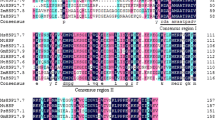Abstract
Heat shock protein 90 (Hsp90), known as molecular chaperone, is involved in protein folding and assembly in the cell. In the present study, a full-length cDNA named Vitis pseduoreticulta heat shock protein 90 (VpHsp90) (GenBank accession Number:EU239815), encoding a heat shock protein 90, was obtained by degenerated primers and 3′-and 5′-RACE from Vitis pseudoreticulata according to our previously obtained EST sequence (GenBnak accession number:DV182112), putatively known as Hsp90. Comparison of VpHsp90 sequence has revealed that an open reading frame (ORF) consists of 2,100 bp nucleotides and the translated proteins of 699 amino acid residues. The molecular mass of VpHsp90 calculated from the deduced amino acid sequence was 80.2 kDa, Isolectric Point was 4.893, which is in close proximity of Hsp90. The maximum similarity of VpHsp90 at nucleotides level (85%) and protein level (96%) was found to be with Nicotiana tabacum. Phylogenetic tree analysis at both the nucleotides and amino acids levels indicates that Vitis pseduoreticulata, Nicotiana tabacum, and Arabidopsis thaliana Hsp90 sequences comprise one clade, which is closely related to Oryza sativa, Hordeum vulgare and Triticum aestivum Hsp90s. It may be reasonably concluded that VpHsp90 possesses the ancestral gene of Hsp90 similar to that of higher plant species.
Similar content being viewed by others
References
Avrom J.C., Atin K.M. & Maria A.T. 2006. Molecular chaperones and protein kinase quality control. Trends Cell Biol. 2: 87–92.
Buchner J. 1999. Hsp90 & Co. - A holding for folding. Trends Bioch. Sci. 24: 136–141.
Dittmar K.D., Demady D.R., Stancato L.F., Krishna P. & Pratt W.B. 1997. Folding of the glucocorticoid receptor by the heat shock protein (hsp) 90-based chaperone machinery. The role of p23 is to stabilize receptor hsp90 heterocomplexes formed by hsp90-p60-hsp70. J. Biol. Chem. 272: 21213–21220
Frydman J. 2001. Folding of newly translated proteins in vivo: the role of molecular chaperones. Annu. Rev. Biochem. 70: 603–647
Kamal A., Thao L., Sensintaffar J., Zhang L., Boehm M.F., Fritz L.C. & Burrows F.J. 2003. A high-affinity conformation of Hsp90 confers tumour selectivity on Hsp90 inhibitors. Nature 425: 407–410.
Kovacs J.J., Murphy P.J.M., Gaillard S., Zhao X., Wu J.-T. Nicchitta C.V., Yoshida M., Toft D.O., Pratt W.B. & Yao T.- P. 2005. HDAC6 regulates Hsp90 acetylation and chaperonedependent activation of glucocorticoid receptor. Mol. Cell. 18: 601–607.
Nathan D.F., Vos M.H. & Lindquist S.1997. In vivo functions of the Saccharomyces cerevisiae Hsp90 chaperone. Proc. Natl. Acad. Sci. USA. 94: 12949–12956.
Olsen L.J. & Harada J.J. 1995. Peroxisomes and their assembly in higher plants. Annu. Rev. Plant Physiol. 46: 123–146.
Pearl L.H. & Prodromou C. 2006. Structure and mechanism of the Hsp90 molecular chaperone machinery. Annu. Rev. Biochem. 75: 271–294.
Picard D. 2006. Chaperoning steroid hormone action. Trends Endocrinol. Metab. 17: 229–235.
Pratt W.B. & Toft D.O. 2003. Regulation of signaling protein function and trafficking by the hsp90/hsp70-based chaperone machinery. Exp. Biol. Med. 228: 111–133.
Sangster T.A., Lindquist S. & Queitsch C. 2004. Under cover: Causes, effects and implications of Hsp90-mediated genetic capacitance. Bioessays 26: 348–362.
Stancato L.F., Hutchison K.A., Krishna P. & Pratt W.B. 1996. Animal and plant cell lysates share a conserved chaperone system that assembles the glucocorticoid receptor into a functional heterocomplex with Hsp90. Biochemistry 35: 554–561.
Whitesell L. & Lindquist S.L. 2005. HSP90 and the chaperoning of cancer. Nat. Rev. Cancer. 5: 761–772.
William B.P., Priti K. & Laura J.O. 2001. Hsp90-binding immunophilins in plants: the protein movers. Trends Plant Sci. 2: 54–58.
Xu Y. & Wang Y.J. 2006. Construction of a cDNA library of Vitis pseudoreticulata native to China inoculated with Uncinula necator and the analysis of potential defense related expressed sequences tags. Hortscience 41: 1006
Young J., Moarefi I. & Hartl F.U. 2001. Hsp90: A specialized but essential protein-folding tool. J. Cell Biol. 154: 267–273.
Zhang J.J., Wang Y.J., Wang X.P., Yang K.Q. & Yang J.X. 2003. An improved method for rapidly extracting total RNA from Vitis. J. Fruit Sci. China 20: 178–189.
Author information
Authors and Affiliations
Corresponding author
Rights and permissions
About this article
Cite this article
Xu, Y., Wang, Y. Molecular cloning and characterization of novel heat shock protein 90 gene from a wild Vitis pseduoreticulata native to China. Biologia 64, 102–106 (2009). https://doi.org/10.2478/s11756-009-0008-8
Received:
Accepted:
Published:
Issue Date:
DOI: https://doi.org/10.2478/s11756-009-0008-8




